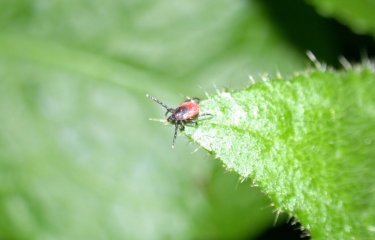-
Fiche maladie | 2021.07.22
Lyme disease (Lyme borreliosis)
Lyme disease, also known as Lyme borreliosis, is a tick-borne disease. It is the most widespread vector-borne disease in the entire northern hemisphere. Its incidence continues to rise at global level as a result of demographic and environmental factors, including climate change.
-
Vidéo | 2025.05.12
Lyme disease: a vaccine at last?
Lyme borreliosis: messenger RNA, a promising new vaccine lead?Valérie Choumet and her team at the Institut Pasteur have obtained promising results for a new candidate vaccine against Lyme disease.Using messenger RNA technology - already proven for other infectious diseases - this vaccine targets the OspA protein present on the surface of the Borrelia burgdorferi bacterium responsible for this...
-
News | 2018.09.07
Lyme disease: a study on the speed of transmission by infected ticks
Lyme borreliosis is a disease caused by bacteria of the genus Borrelia that are transmitted by a bite from a tick of the genus Ixodes. Scientists from the Institut Pasteur used mice to study the transmission of bacteria by ticks infected with various European and North American species of Borrelia. They found evidence of rapid bacterial transmission following a bite, with infection occurring...
-
Article | 2017.01.05
MOOC Medical entomology - Insect vectors and transmission of pathogens
The MOOC Medical entomology focuses on the insects and arthropods that impact human health as well as the associated diseases, such as malaria, dengue, Zika, Lyme borreliosis, Chagas disease…
-
News | 2017.09.15
Lyme disease – chipmunks may affect tick infection but the risk of transmission is more complex
Lyme disease is caused by bacteria transmitted by the bite of an infected tick of the Ixodes genus. Researchers from the Institut Pasteur have investigated tick infection when Siberian chipmunks are present, as these rodents are thought to be a reservoir for the bacteria. This pet, which was popular in the 1970s, was introduced to some forests where it now thrives, like in Sénart Forest, south-...
-
News | 2016.12.02
MOOC Medical entomology - Insect vectors and transmission of pathogens
The MOOC Medical entomology focuses on the insects and arthropods that impact human health as well as the associated diseases, such as malaria, dengue, Zika, Lyme borreliosis, Chagas disease… This MOOC will begin on february 6, 2017, for six weeks. Enrollments have begun.MOOC in english, subtitled in french and english.Read the article in french
-
Vidéo | 2025.09.08
Close-up of a tick!
Do you know what a tick looks like when viewed VERY closely?Christine Schmitt, a researcher at the Institut Pasteur, takes us into the infinitely small world to reveal the secrets of Ixodes ricinus... and the bacterium responsible for Lyme disease.Using electron imaging, her team observes the tick, its harpoon-shaped mouthparts, and even the Borrelia bacteria, down to its hidden flagella.A...
-
News | 2024.07.02
Climate and health: anticipating tomorrow's vector-borne diseases in France
The impact of climate change on the emergence of diseases is well established. This is particularly true of diseases transmitted by blood-feeding insects, of which the tiger mosquito is now a well-known vector in mainland France. The Fondation Crédit Mutuel Alliance Fédérale is working alongside the Institut Pasteur to combat these diseases, as part of its commitment to the public interest and to...
-
News | 2022.10.19
Interview: INRAE and the Institut Pasteur strengthen their collaboration
The Institut Pasteur and INRAE are strengthening their partnership to tackle infectious and toxic risks and prevent zoonotic diseases. Christophe d'Enfert, Senior Executive Scientific Vice-President at the Institut Pasteur, tells us about the importance of this partnership that focuses on the biology of living systems with the aim of improving animal and human health.
-
Portrait | 2024.06.28
Mathieu Picardeau: tackling the trio of water, rats and leptospirosis
Mathieu Picardeau is Head of the Biology of Spirochetes Unit and the National Reference Center for Leptospirosis at the Institut Pasteur. Mathieu is warm, friendly and well-read, with a passion for contemporary art in his free time – but what really gets him excited is a very specific family of bacteria, some of which are fatal for humans. Despite his many responsibilities, he spends time in the...

